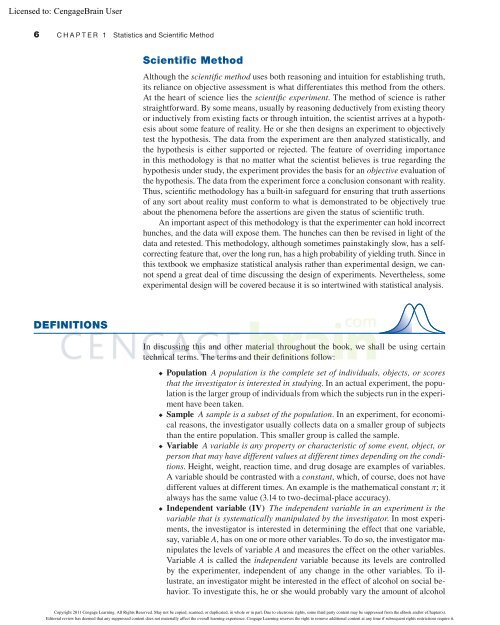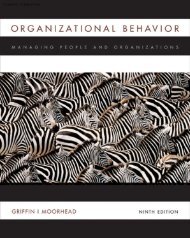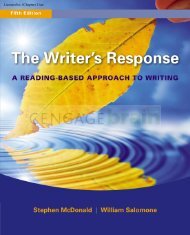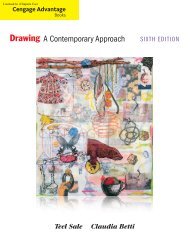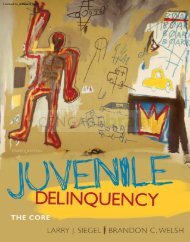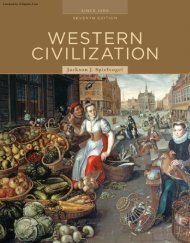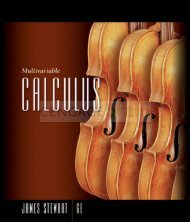Understanding Statistics in the Behavioral Sciences ... - NelsonBrain
Understanding Statistics in the Behavioral Sciences ... - NelsonBrain
Understanding Statistics in the Behavioral Sciences ... - NelsonBrain
Create successful ePaper yourself
Turn your PDF publications into a flip-book with our unique Google optimized e-Paper software.
Licensed to:<br />
6 C H A P T E R 1 <strong>Statistics</strong> and Scientifi c Method<br />
DEFINITIONS<br />
Scientifi c Method<br />
Although <strong>the</strong> scientifi c method uses both reason<strong>in</strong>g and <strong>in</strong>tuition for establish<strong>in</strong>g truth,<br />
its reliance on objective assessment is what differentiates this method from <strong>the</strong> o<strong>the</strong>rs.<br />
At <strong>the</strong> heart of science lies <strong>the</strong> scientifi c experiment. The method of science is ra<strong>the</strong>r<br />
straightforward. By some means, usually by reason<strong>in</strong>g deductively from exist<strong>in</strong>g <strong>the</strong>ory<br />
or <strong>in</strong>ductively from exist<strong>in</strong>g facts or through <strong>in</strong>tuition, <strong>the</strong> scientist arrives at a hypo<strong>the</strong>sis<br />
about some feature of reality. He or she <strong>the</strong>n designs an experiment to objectively<br />
test <strong>the</strong> hypo<strong>the</strong>sis. The data from <strong>the</strong> experiment are <strong>the</strong>n analyzed statistically, and<br />
<strong>the</strong> hypo<strong>the</strong>sis is ei<strong>the</strong>r supported or rejected. The feature of overrid<strong>in</strong>g importance<br />
<strong>in</strong> this methodology is that no matter what <strong>the</strong> scientist believes is true regard<strong>in</strong>g <strong>the</strong><br />
hypo<strong>the</strong>sis under study, <strong>the</strong> experiment provides <strong>the</strong> basis for an objective evaluation of<br />
<strong>the</strong> hypo<strong>the</strong>sis. The data from <strong>the</strong> experiment force a conclusion consonant with reality.<br />
Thus, scientifi c methodology has a built-<strong>in</strong> safeguard for ensur<strong>in</strong>g that truth assertions<br />
of any sort about reality must conform to what is demonstrated to be objectively true<br />
about <strong>the</strong> phenomena before <strong>the</strong> assertions are given <strong>the</strong> status of scientifi c truth.<br />
An important aspect of this methodology is that <strong>the</strong> experimenter can hold <strong>in</strong>correct<br />
hunches, and <strong>the</strong> data will expose <strong>the</strong>m. The hunches can <strong>the</strong>n be revised <strong>in</strong> light of <strong>the</strong><br />
data and retested. This methodology, although sometimes pa<strong>in</strong>stak<strong>in</strong>gly slow, has a selfcorrect<strong>in</strong>g<br />
feature that, over <strong>the</strong> long run, has a high probability of yield<strong>in</strong>g truth. S<strong>in</strong>ce <strong>in</strong><br />
this textbook we emphasize statistical analysis ra<strong>the</strong>r than experimental design, we cannot<br />
spend a great deal of time discuss<strong>in</strong>g <strong>the</strong> design of experiments. Never<strong>the</strong>less, some<br />
experimental design will be covered because it is so <strong>in</strong>tertw<strong>in</strong>ed with statistical analysis.<br />
In discuss<strong>in</strong>g this and o<strong>the</strong>r material throughout <strong>the</strong> book, we shall be us<strong>in</strong>g certa<strong>in</strong><br />
technical terms. The terms and <strong>the</strong>ir defi nitions follow:<br />
◆ Population A population is <strong>the</strong> complete set of <strong>in</strong>dividuals, objects, or scores<br />
that <strong>the</strong> <strong>in</strong>vestigator is <strong>in</strong>terested <strong>in</strong> study<strong>in</strong>g. In an actual experiment, <strong>the</strong> population<br />
is <strong>the</strong> larger group of <strong>in</strong>dividuals from which <strong>the</strong> subjects run <strong>in</strong> <strong>the</strong> experiment<br />
have been taken.<br />
◆ Sample A sample is a subset of <strong>the</strong> population. In an experiment, for economical<br />
reasons, <strong>the</strong> <strong>in</strong>vestigator usually collects data on a smaller group of subjects<br />
than <strong>the</strong> entire population. This smaller group is called <strong>the</strong> sample.<br />
◆ Variable A variable is any property or characteristic of some event, object, or<br />
person that may have different values at different times depend<strong>in</strong>g on <strong>the</strong> conditions.<br />
Height, weight, reaction time, and drug dosage are examples of variables.<br />
A variable should be contrasted with a constant, which, of course, does not have<br />
different values at different times. An example is <strong>the</strong> ma<strong>the</strong>matical constant π; it<br />
always has <strong>the</strong> same value (3.14 to two-decimal-place accuracy).<br />
◆ Independent variable (IV) The <strong>in</strong>dependent variable <strong>in</strong> an experiment is <strong>the</strong><br />
variable that is systematically manipulated by <strong>the</strong> <strong>in</strong>vestigator. In most experiments,<br />
<strong>the</strong> <strong>in</strong>vestigator is <strong>in</strong>terested <strong>in</strong> determ<strong>in</strong><strong>in</strong>g <strong>the</strong> effect that one variable,<br />
say, variable A, has on one or more o<strong>the</strong>r variables. To do so, <strong>the</strong> <strong>in</strong>vestigator manipulates<br />
<strong>the</strong> levels of variable A and measures <strong>the</strong> effect on <strong>the</strong> o<strong>the</strong>r variables.<br />
Variable A is called <strong>the</strong> <strong>in</strong>dependent variable because its levels are controlled<br />
by <strong>the</strong> experimenter, <strong>in</strong>dependent of any change <strong>in</strong> <strong>the</strong> o<strong>the</strong>r variables. To illustrate,<br />
an <strong>in</strong>vestigator might be <strong>in</strong>terested <strong>in</strong> <strong>the</strong> effect of alcohol on social behavior.<br />
To <strong>in</strong>vestigate this, he or she would probably vary <strong>the</strong> amount of alcohol<br />
Copyright 2011 Cengage Learn<strong>in</strong>g. All Rights Reserved. May not be copied, scanned, or duplicated, <strong>in</strong> whole or <strong>in</strong> part. Due to electronic rights, some third party content may be suppressed from <strong>the</strong> eBook and/or eChapter(s).<br />
Editorial review has deemed that any suppressed content does not materially affect <strong>the</strong> overall learn<strong>in</strong>g experience. Cengage Learn<strong>in</strong>g reserves <strong>the</strong> right to remove additional content at any time if subsequent rights restrictions require it.


